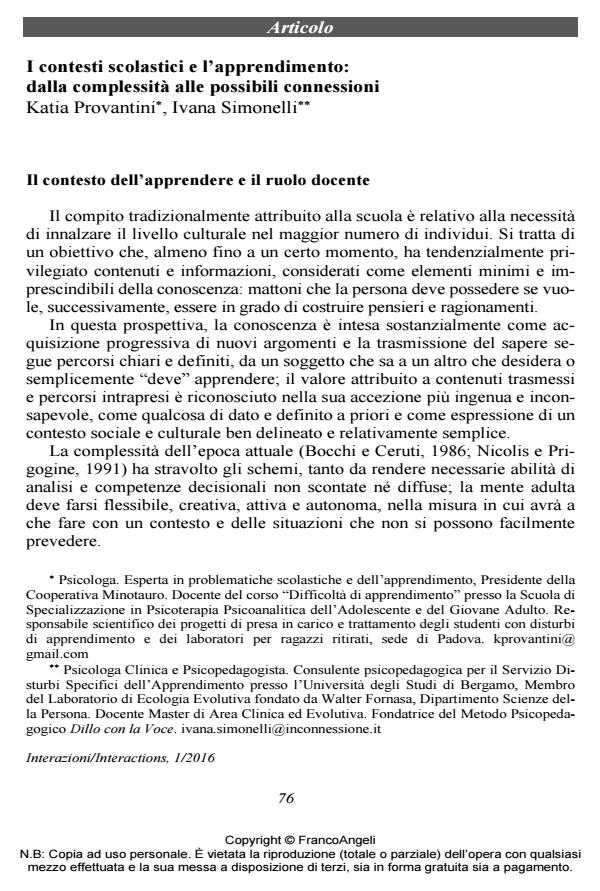Scholastic contexts: from complexit to possible connections
Journal title INTERAZIONI
Author/s katia Provantini, Ivana Simonelli
Publishing Year 2016 Issue 2016/1 Language Italian
Pages 12 P. 76-87 File size 176 KB
DOI 10.3280/INT2016-001007
DOI is like a bar code for intellectual property: to have more infomation
click here
Below, you can see the article first page
If you want to buy this article in PDF format, you can do it, following the instructions to buy download credits

FrancoAngeli is member of Publishers International Linking Association, Inc (PILA), a not-for-profit association which run the CrossRef service enabling links to and from online scholarly content.
The authoresses want to look into social, psychic and pedagogic aspects which characterize the school context and which bear upon the dynamics between the processes of teaching and of learning in the specific adolescent evolutionary phase. Teachers today have to exercise expertises considering the number of cognitive, relational, emotive, evolutionary, cultural and digital elements that are involved in learning. Children are influenced by scholastic experiences. Therefore, thoughts and perceptions follow them at school: the risk is corrupting the student role, increasing the sense of being uncertain about the future, of disputing himself in case of mistakes, defeats and fails. The contribute shows how to bring to schools a way to give the right meaning to unforeseen events, mistakes, lacks of learning. It is thus possible to understand which teaching methods can better respond to new adolescents ways of learning.
Keywords: Learning, teaching, adolescent, teaching methods, expertises
- Bocchi G., Ceruti M. (1986) (a cura di). La sfida della complessità. Milano: Feltrinelli.
- Bateson G. (1977). Verso un’ecologia della mente. Milano: Adelphi.
- Fornasa W. (2000). Lavorare per progetti verso la competenza evolutiva. Atti del convegno “L’educazione ambientale alle soglie del terzo millennio”, Bolzano 21.10.2000.
- Fornasa W. (2006). Oltre l’occhio di Polifemo. Costruzione, cambiamento e processi educativi. Consultabile su www.costruttivismoedidattica.it
- Fornari F. (1982). Codici affettivi e rapporto corpo/mente. Psicologia Clinica, I, 1: 33-69.
- Medeghini R., Fornasa W. (2011) (a cura di). L’educazione inclusiva. Milano: FrancoAngeli.
- Nicolis G., Prigogine I. (1991). La complessità. Esplorazioni nei nuovi campi della scienza. Torino: Einaudi.
- Perticari P. (2012). Alla prova dell’inatteso. Scuola e crisi educativa. Dalla malaripetizione agli insegnamenti profondi. Roma: Armando.
- Pietropolli Charmet G. (2000). I Nuovi Adolescenti. Milano: Raffello Cortina.
- Pietropolli Charmet G. (2009). Fragile e spavaldo. Ritratto dell’adolescente di oggi. Bari: Laterza.
- Provantini K. (2007). L’adolescenza oggi: il punto di vista psicologico. In: Scandella O. (a cura di), Interpretare la tutorship. Nuovi significati e pratiche nella scuola dell’au to nomia. Milano: Franco Angeli.
- Provantini K. (2013). Scuola media: manuale per la sopravvivenza. Cosa occorre sapere per non farsi travolgere. Milano: Mondadori.
- Provantini K., Longoni M. (2014). Generazione Tablet. I sì e i no per crescere nell’era del web. Milano: Mondadori.
- Simonelli I., Fornasa W. (2009). La scala WISC (Wechsler Intelligence Scale for Children): vincoli, risorse e possibilità. Psicologia dell’Educazione e della Formazione, 11: 31-52.
- Guerra in Ucraina. Accogliere i pensieri e le emozioni dei bambini e dei ragazzi da 3 a 18 anni nei contesti scolastici Ivana Simonelli, in PSICOBIETTIVO 3/2022 pp.87
DOI: 10.3280/PSOB2022-003008
katia Provantini, Ivana Simonelli, I contesti scolastici e l’apprendimento: dalla complessità alle possibili connessioni in "INTERAZIONI" 1/2016, pp 76-87, DOI: 10.3280/INT2016-001007